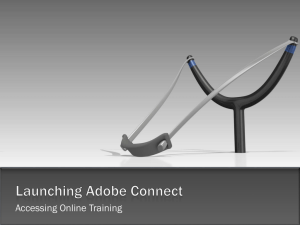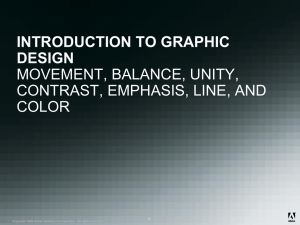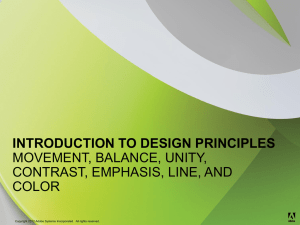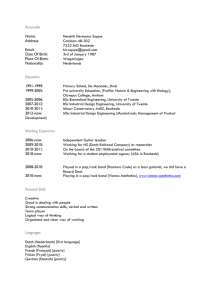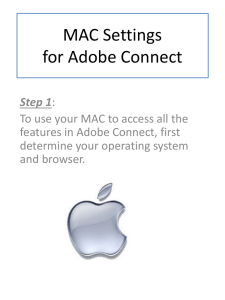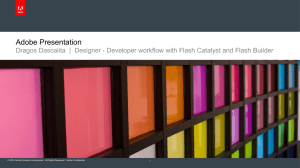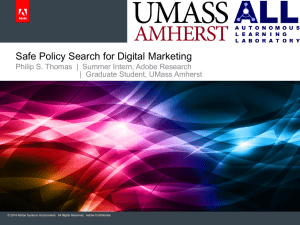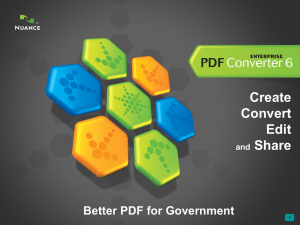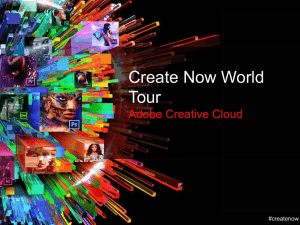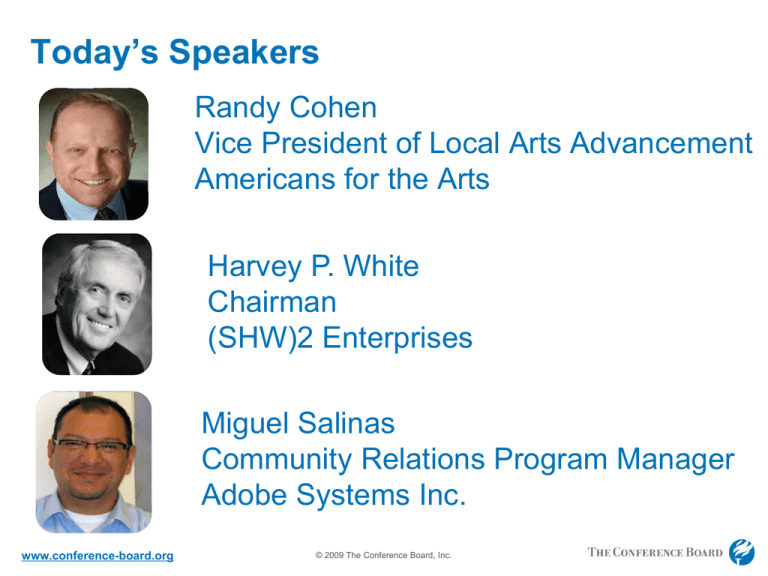
Today’s Speakers
Randy Cohen
Vice President of Local Arts Advancement
Americans for the Arts
Harvey P. White
Chairman
(SHW)2 Enterprises
Miguel Salinas
Community Relations Program Manager
Adobe Systems Inc.
www.conference-board.org
© 2009 The Conference Board, Inc.
Percentage of SAT Test Takers with
4 Years of Arts or Music in High School
25%
20.2%
20%
17.0%
15.4%
15.5%
15.3%
14.9%
1998
1999
2000
2001
15.6%
15.9%
2002
2003
18.7%
18.4%
18.9%
2006
2007
2008
17.7%
15%
10%
5%
0%
2004
2005
2009
College Arts Degrees in U.S. (1996-2008)
140,000
115,318
120,000
107,877
3.4% of All Degrees
100,393
100,000
80,000
74,177
75,363
1996
1997
79,365
122,210
118,066 119,964 120,561
83,927
87,936
92,154
4.1% of All Degrees
60,000
40,000
20,000
0
1998
1999
2000
2001
2002
2003
2004
2005
2006
2007
2008
Arts Students Outperform Non-Arts Students:
Average Points Better on SAT Scores
120
100
100
104
103
93
89
91
80
98
87
85
91
67
60
40
20
0
1999
2000
2001
2002
2003
2004
2005
2006
2007
2008
2009
Arts Education Improves
Cognitive Development
Arts strengthens attention and memory
“muscles”
• Dance . . . observation skills
• Acting . . . memory and speech
• Music . . . reading and analytical thinking
www.dana.org
STEAM
Harvey P. White
The Conference Board
June 22, 2010
STEAM
• Even in this politically partisan time virtually everyone agrees that our country’s
future is tied directly to our success as innovators.
• Clinton’s former Secretary of Education, Richard Riley, summed up this need for
innovation to drive our future when he predicted,
“the jobs in the greatest demand in the future don’t yet exist and will require
workers to use technologies that have not yet been invented to solve problems that
we don’t yet even know are problems.”
• By now probably some of that prediction is already occurring.
• So the question isn’t what is necessary for our economic future – but, rather how do
we best prepare our nation to make it happen?
• The nation has undertaken and funded a virtual mandate to encourage and expand
STEM education at all levels, which I support – but I believe that while
STEM education is necessary it is not sufficient
STEAM
• The need for Arts as an essential part of the education system is becoming
understood as not just a nice thing that some parent in the local PTA lobbies for, but
rather is a critical need for the success of our national economic future.
• In an address in April this year Education Secretary Arne Duncan said :
“The arts can no longer be treated as frill. Arts education is essential to
stimulating the creativity and innovation that will prove critical to young
Americans competing in a global economy.”
• Dr. Alan Brinkley, the Nevins professor and former Provost of Columbia University,
headlines his recent article in Newsweek , “Half a Mind is a Terrible Thing to Waste”.
• The article’s sub title, which he covers in some depth reads:
“The idea that we must choose between science and humanities is false”
• He supports excellence in technical education but points out the dual need “Scientific and technology aspire to clean, clear answers to problems (as elusive as
those answers might be). The humanities address ambiguity, doubt and
skepticism – essential underpinnings in a complex and diverse and turbulent
world.”
STEAM
• I am glad this dialog on the criticality of including arts in our education system at all
levels has begun as we see that to maintain our position as one of the world’s leading
economies we must lead in innovation and arts education plays an essential role in
innovation.
• The relationship of arts to innovation has a long history in the academic world but, it
is just now becoming understood to what I believe is an economic necessity.
• For example a study of 150 biographies of eminent scientists, from Pasteur to
Einstein was done in the early 1990’s by Robert Root-Bernstein, a biochemist and
MacArthur prize winner.
▫ Root-Bernstein discovered that nearly all of the great inventors and scientists
were also musicians, artists, writers or poets. For example Galileo, was a poet and
literary critic; Einstein was a passionate student of the violin; Samuel Morse, the
father of telecommunications was a portrait painter, etc.
▫ Root-Bernstein and his wife, Michele, co-authors of Sparks of Genius, conducted
extensive research into the minds of inventive people and showed that creativity
can be encouraged and enhanced through the exercise of thinking tools.
• Without exercising this other half of the brain with its ability to foster creativity it
atrophies just as failure to do physical exercise does for other parts of the body.
STEAM
The difference between Chinese and
American parents…
Source: Newsweek Magazine
STEAM
• A recent study of 58 countries showed that the US is no longer rated first in the world
in innovation. It has slipped to 3rd behind Singapore and Hong Kong. China has
risen to 18th.
• Historically we have lead in innovation because of our greater number of personnel
with superior technical skills. The thought that this can hold true in the future needs
to change because we will lose that numeric advantage for two reasons –
First the emerging nations are driving for the same superior technical skill level
of its personnel and their population size dwarfs ours
Second we have historically trained their personnel and they have stayed in the
US to innovate here – they are now returning to their home countries due to
the better opportunities combined with our pathetic immigration policies.
• So we must prepare our superior technical graduates and others with the best tools
possible to either equal our competitor nations tools or better them.
• To do so we must use both sides of our brain – we need to have superior technical
skill combined with the practiced creative skills provided by including Arts as an
integral and necessary part of our national mandate in order to prepare our nation to
compete and achieve the highest level of innovation.
STEAM
• SUMMARY
• We all agree that the US must innovate to remain one of the world’s leading
economies. We must equip ourselves with the best and most complete set of skills to
be competitive.
• A continued high degree of competency in science, technology, engineering and
mathematics is an essential element of such a set of skills. We will find increasing
competition in this arena and we need to reinstate a level of creativity to augment
this technical competency that has been lost by budget concerns.
• We need to create an national understanding this loss will become a huge economic
mistake, especially as our ability to compete in the manufacturing and many service
sectors declines.
• We must lead the effort to make sure there is an understanding that including Arts in
the curricula of all schools at all levels is not just a nice thing to do but an economic
necessity.
• For the future of our nation and to maintain the prosperity and current life style for
the generations to follow us we need to act now.
About Adobe Youth Voices
Signature initiative of the
Adobe Foundation
Launched in 2006
Focus on youth 13-18 years old
from underserved communities
600+ participating sites
27,000+ youth engaged
2,000+ educators participating
45 countries
Creating media for social
change: video documentaries,
photo essays, audio diaries,
animation
2006 Adobe Systems Incorporated. All Rights Reserved.
13
Program Design
Create With Purpose
Youth development through purposeful self-expression
Empower youth in underserved communities with real world experiences and 21st
century tools to communicate their ideas, exhibit their potential, and take action in
their communities.
Engage
Enhance
Exhibit
Youth
in breakthrough
experiences using
digital tools in and
out of school
Skills
of teachers/adults
working with youth
using digital tools to
communicate
Youth share their
visions and voices to
a broad audience for
a public purpose
2006 Adobe Systems Incorporated. All Rights Reserved.
14
Youth Speaking Out on Issues Important to Them
2006 Adobe Systems Incorporated. All Rights Reserved.
15
Youth are engaged and making a difference
It gives us a different perspective
on how to learn and it brings a
fresh breath of air to education…”
-- Student at Build San Francisco
Institute
“A lot of young people don’t really
know how to speak their minds.
Adobe Youth Voices helps them
get past that...” – Student from
Boys & Girls Club of East Palo
Alto
“It’s changed me a lot because
before I started doing Adobe
Youth Voices I went through a
very difficult stage. Now I get to
express how I feel through a
camera and my poetry…” -Student from Boys & Girls Club of
East Palo Alto
2006 Adobe Systems Incorporated. All Rights Reserved.
16
AYV Outcomes and Evaluation
AYV Educator
Outcomes
AYV Youth Outcomes
Media and technology
skills
Media
and technology
skills
Critical thinking skills
Pedagogical skills
Collaboration skills
Understanding of youth
development
Youth voice
Attitudes toward
technology
Facilitating youth media
Attitudes toward media
2006 Adobe Systems Incorporated. All Rights Reserved.
17
Evaluation Results: Youth Outcomes
85%
of youth agree that their opinion matters at the end
of the program
93% of youth improved at least one media/technology
skill
60% improved 5 or more media/technology skills
66% of youth improved on at least one collaboration skill
93% of youth report that they are interested in continuing
their education after high school
89.7% of youth report being eager to do well in school
2006 Adobe Systems Incorporated. All Rights Reserved.
18
Evalution Results: Educator Outcomes
Educators continue to show gains in:
Technology and media-making skills: includes both
software/hardware skills understanding of concepts like
story-telling, media formats and media literacy, 80%
Understanding of youth development: Awareness of how
to tap into youth interest and motivation, 70%
Youth media facilitation: Understanding of the youth
media field and 21st
century skills, 78%
2006 Adobe Systems Incorporated. All Rights Reserved.
19
Putting the Webcast to Work
1. Do we use our philanthropic dollars to encourage the
desired creative skill sets?
2. Do we have any internal training/development
programs that directly address creativity? Are they
integrated into our standard training programs?
3. Can we expand our thinking around support of the
arts beyond a “nice-to-have”?
www.conference-board.org
© 2009 The Conference Board, Inc.



